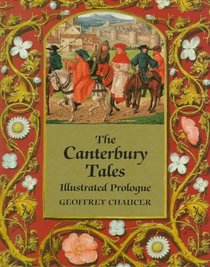Revisiting Geoffrey Chaucer During National Poetry Month
National Poetry Month is the perfect opportunity to revisit Geoffrey Chaucer – the father of English literature who is also considered to be one of the greatest poets of the Middle Ages – and one of his most significant poems – the Prologue to the “Canterbury Tales.”
“For centuries, Chaucer has been regarded as having enhanced English writing giving it an expanded vocabulary and a pleasing verse form that placed England’s poetry on the map internationally and inspired generations of English writers to come,” said Peggy Knapp, professor of English in Carnegie Mellon University’s Dietrich College of Humanities and Social Sciences.
Knapp, an expert on Chaucer, also said that “The Prologue to Chaucer’s ‘Canterbury Tales’ was written in English at a time when much serious poetry appeared in either scholarly Latin or courtly French.”
The Prologue to the "Canterbury Tales"
WHAN that Aprille with his shoures soote
The droghte of Marche hath perced to the roote,
And bathed every veyne in swich licour,
Of which vertu engendred is the flour;
Whan Zephirus eek with his swete breeth
Inspired hath in every holt and heeth
The tendre croppes, and the yonge sonne
Hath in the Ram his halfe cours y-ronne,
And smale fowles maken melodye,
That slepen al the night with open ye,
(So priketh hem nature in hir corages);
Than longen folk to goon on pilgrimages,
And palmers for to seken straunge strondes,
To ferne halwes, 9 couthe 10 in sondry londes;
And specially, from every shires ende
Of Engelond, to Caunterbury they wende,
The holy blisful martir for to seke,
That hem hath holpen, whan that they were seke.
The poem can be difficult to read, so Knapp analyzed the language used and the meaning behind it.
“The spring song that begins the Prologue, ‘Whan that Aprill with his shoures soote,’ is an old form, familiar since Anglo-Saxon verse (Old English),” she said. “It’s a fine achievement as a tribute to spring, as the many students over the years who have been asked to learn it by heart have discovered.”
Further exploring the spring song, Knapp said, “Spring causes the restless little birds to sleep all night with their eyes open and people to want to go places, inflecting the exuberance of the season with a subtle sexiness, which echoes through the tales that follow and gives those tales a distinctive irony.”
By the time the eighteen lines of the spring song conclude, Knapp said, “We see the portraits of the pilgrims that follow, as well as the tales themselves, as widely varied; some of them sincerely honor the saint, Thomas à Becket, the ‘hooly blissful martir’ toward whose shrine they are headed.”
The Prologue then goes on to name and describe the pilgrims in terms of their roles in the late medieval economy: the Knight, the Miller and the Prioress.
“But, in all but a few cases -and not everyone agrees on which ones- something keeps the pilgrim from being a perfect fit with the ideals of his or her station,” Knapp said. “The Knight was a crusader, but does the description of his career honor or criticize the crusades?”
She also clarified how each portrait in the Prologue sheds light on the tale the pilgrim will tell and prompts readers to interpret each of them as fully developed fictional persons and how no earlier narrative poetry had achieved this blend of social satire and character development.
Then, led by the proprietor of the inn from which they embark, the pilgrims decide to entertain each other by telling stories as they make their journey to Canterbury. They draw straws to see who will tell their story first.
“They set off to Canterbury and the Prologue ends. And, if the Prologue were to stand alone, it would be a great poem,” Knapp said. “It is beautifully crafted in iambic couplets, presenting a wide-ranging account of late medieval society and employing a style of unmatched irony and satire.”
For CMU students interested in learning more about Chaucer, Knapp teaches “Chaucer” through the Dietrich College’s English Department.
Listen to a reading of Chaucer's Prologue to the "Canterbury Tales."
_______
By: Amanda King